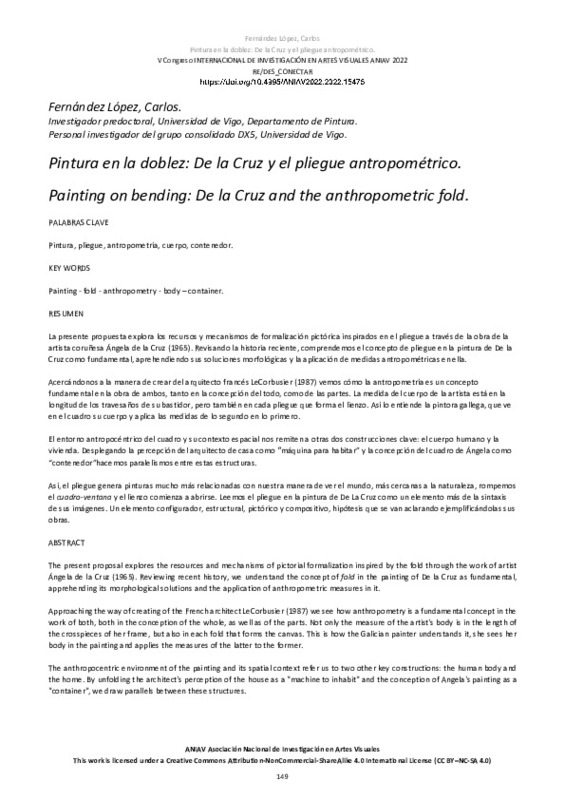|
Resumen:
|
[EN] The present proposal explores the resources and mechanisms of pictorial formalization inspired by the fold through the work of artist
Ángela de la Cruz (1965). Reviewing recent history, we understand the concept of ...[+]
[EN] The present proposal explores the resources and mechanisms of pictorial formalization inspired by the fold through the work of artist
Ángela de la Cruz (1965). Reviewing recent history, we understand the concept of fold in the painting of De la Cruz as fundamental,
apprehending its morphological solutions and the application of anthropometric measures in it.
Approaching the way of creating of the French architect LeCorbusier (1987) we see how anthropometry is a fundamental concept in the
work of both, both in the conception of the whole, as well as of the parts. Not only the measure of the artist's body is in the length of
the crosspieces of her frame, but also in each fold that forms the canvas. This is how the Galician painter understands it, she sees her
body in the painting and applies the measures of the latter to the former.
The anthropocentric environment of the painting and its spatial context refer us to two other key constructions: the human body and
the home. By unfolding the architect's perception of the house as a "machine to inhabit" and the conception of Angela's painting as a
"container", we draw parallels between these structures. Thus, the fold generates paintings much more related to our way of seeing the world, closer to nature, we break the painting-window
and the canvas begins to open. We read the fold in De La Cruz's painting as one more element of the syntax of her images. A configuring,
structural, pictorial and compositional element, hypotheses that are clarified by exemplifying her works.
[-]
[ES] Esta propuesta trata de explorar y entender el presente de los recursos y mecanismos de formalización pictórica contemporáneos inspirados en el pliegue. Revisando el conocimiento adquirido en las diferentes experiencias ...[+]
[ES] Esta propuesta trata de explorar y entender el presente de los recursos y mecanismos de formalización pictórica contemporáneos inspirados en el pliegue. Revisando el conocimiento adquirido en las diferentes experiencias artísticas en la historia reciente, analizaremos sus soluciones morfológicas y cómo se manifiestan en la actualidad, tomando de ejemplo la pintura de la coruñesa Ángela De la Cruz. ¿Qué papel tiene el pliegue en la pintura actual? Comprobaremos cómo se aplican pictóricamente las potencialidades del pliegue: las dobleces del cuerpo, la teoría de las supercuerdas, los repliegues de la materia sobre los que habla Deleuze... El término “pliegue” abarca una gran variedad de definiciones y aplicaciones en la pintura, desde el tríptico renacentista de Van Eyck, hasta las fisuras vanguardistas en el soporte de Lucio Fontana. Cuando hablamos de pliegues, también hablamos de enrollamientos, bucles, contorsionismos, nudos... Deleuze recupera la idea leibniziana que defendía que todo se encuentra plegado en el universo. Lo que distingue cada uno de estos elementos presentes en el mundo es el modo en el que se encuentra plegado. La arruga, la huella dactilar, las líneas de la mano nos distinguen. El pliegue es aquello que particulariza. Todos los espacios nuevos que crea la misma doblez en el soporte pictórico, las nuevas geometrías y cualidades inéditas. Entenderemos que muchas de las soluciones de la pintura expandida tienen que ver con metáforas antropomórficas. Así, relacionaremos esta doblez en el soporte pictórico con la piel del cuerpo humano. En los pliegues antropométricos de Ángela De la Cruz vemos el reflejo de una visión contemporánea necesaria en nuestro contexto histórico y cultural. Revisitando la obra de filósofos como Byung-Chul Han o Blanchot, comprobaremos como estas dinámicas son la representación (y presentación) de una sociedad que necesita escapar de lo antinatural del bidimiensional, de lo impuro del plano.
[-]
|









